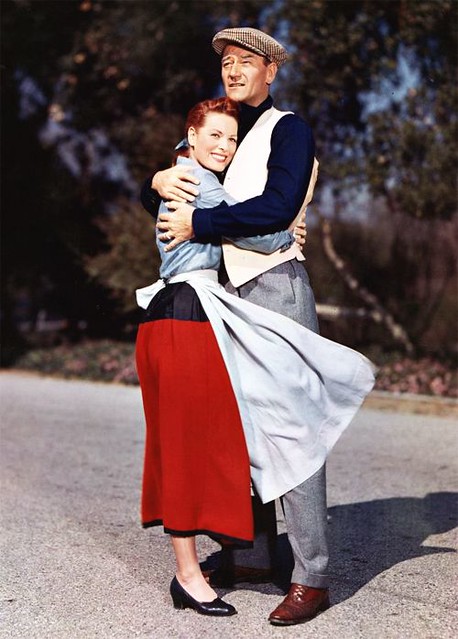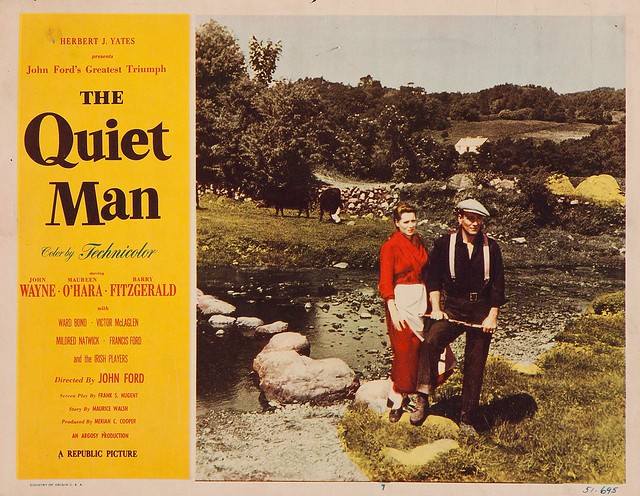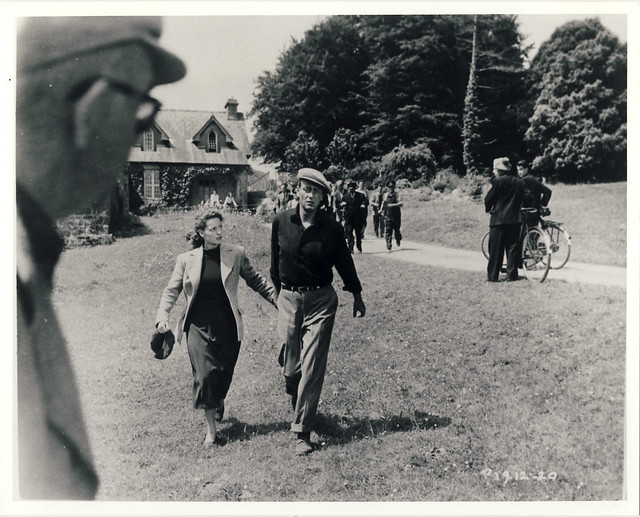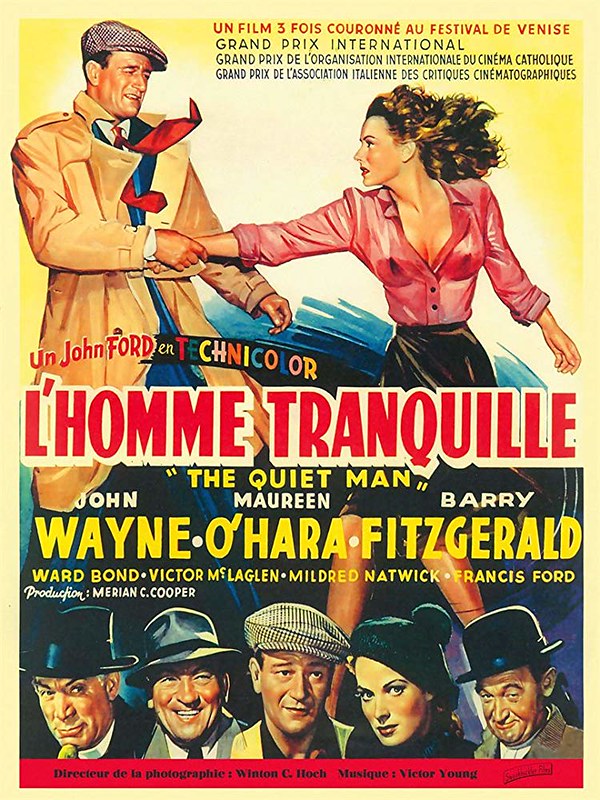WHAT: The Quiet Man (1952, DCP)
WHEN: Wednesday, March 13, 2019 1 PM & 7:30 PM
WHERE: Pickwick Theatre, Park Ridge, IL
WHAT ELSE: Special guest Maggie McEldowney, 2016 International Rose of Tralee
Organist Jay Warren performs prelude music at 7 PM; cartoon before the feature.
HOW MUCH: $12/$10 advance or $8 for the 1 PM matinee. Advance tickets: Click Here!
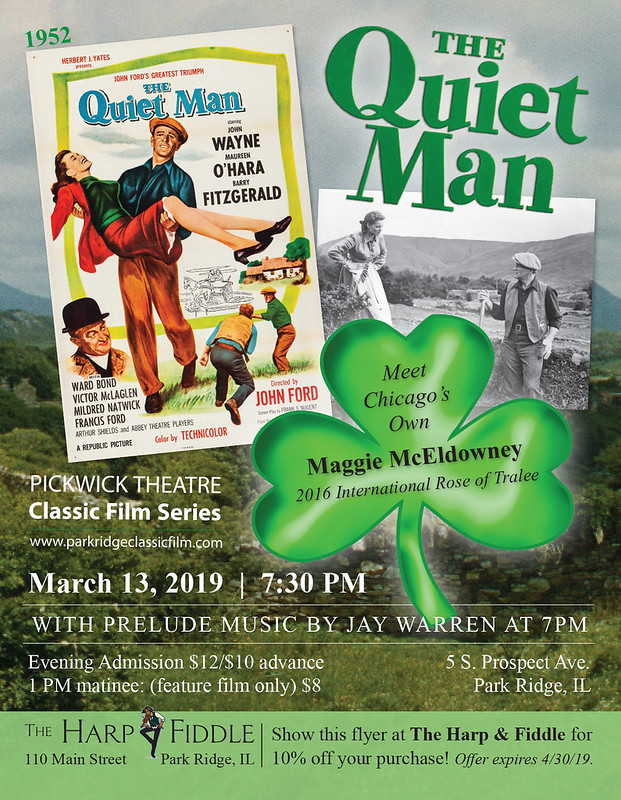
“Andrew McLaglen (second assistant director) watched Ford carefully, saw the way he knew his script, but gave it room to breathe by thinking up bits of business. ‘He knew the picture he wanted to make (and) he had great imagination… I can remember vividly when Duke was striding across the countryside on his way to the station to get Maureen back, and all of a sudden he saw this beautiful green meadow with a whole pack of seagulls, hundreds of seagulls. He said, ‘Quick, get the camera, set it up. Okay Duke, you’re ready? Okay, walk in there.’ Duke strode in there and all those seagulls went up in the air. It was great… He took advantage (of the moment).'” ~ Print the Legend, Scott Eyman
Mary Kate Danaher: It’s a bold one you are! Who gave you leave to be kissin’ me?
Thornton: So you can talk!
Mary Kate Danaher: Yes I can, I will and I do! And it’s more than talk you’ll be gettin’ if you step a step closer to me!
The Quiet Man (1952) is director John Ford’s most popular film with a timeless quality that touches a wide audience. Even those who are not normally John Wayne fans have gravitated toward what has become a St. Patrick’s Day tradition. There is a certain universal quality about The Quiet Man. One does not have to be Irish to appreciate everything the film has to offer. March 13 will be our first screening of this classic at the Pickwick Theatre, and we are looking forward to presenting a stunning 4K restoration in our Megatheatre. To add to the festivities, we will be joined by Chicago’s own Maggie McEldowney, the 2016 International Rose of Tralee. We anticipate this being one of our most successful events of the season.
The Quiet Man is such a beloved film in part because it captures the joy of Ireland– the sense of place and the warmth of its characters. The film, and its journey to the screen, was a lifelong passion for John Ford. It took the better part of twenty years for him to bring the story to theatres. Ford, whose parents were immigrants from Ireland, often drew on his Irish heritage in his films. Since the teens (1917) when he first started to direct movies like The Tornado, elements of home and exile could be found in his work. In time, his stock company of actors developed and became filled with many Irish-Americans. The Quiet Man would be very personal to Ford– something he would never admit publicly– and he would be rewarded for it with his fourth Academy Award for direction.
Written by an Irish writer from County Kerry named Maurice Walsh, The Quiet Man first appeared in The Saturday Evening Post in 1933. At the time of its publication, John Ford was shooting Pilgrimage— one of the films he made that features a strong woman– a grieving mother– as his protagonist. Walsh would re-write the story for a book called Green Rushes, which was a collection of short stories. In 1936, Ford purchased the screen rights from the author for a mere $10 (with the promise of more if he ever made the film). For years, it seemed unlikely it would be made as no studio expressed interest in filming it. According to actress Maureen O’Hara, studios considered it a “silly little Irish story.” Yet, Ford never stopped trying to bring it to the screen. In 1945, he visited Maureen O’Hara on the set of The Spanish Main and offered her the role of Mary Kate Danaher in The Quiet Man. It was a handshake agreement. O’Hara accepted the possibility of starring (should it be made) and even helped Ford type up early drafts of the script in order to save on production costs.
In 1946, John Ford formed Argosy Pictures with his filmmaking partner Merian C. Cooper, but they still couldn’t get funding. They almost had a deal with RKO, but the studio passed when Ford’s The Fugitive turned out to be a commercial failure. Production plans were reactivated in April of 1948 when Ford intended on shooting the film in Dublin, but once again, the money wasn’t there. Ford, however, would find a home at Republic Pictures. John Wayne, who was under contract to Republic, took Ford’s Quiet Man script to the head of the studio, Herbert J. Yates. At this time in the studio’s history, Yates was trying to upgrade his product and make more prestigious films beyond the Westerns and B-movies the studio was known for. He signed Ford to a three-picture deal, but before he would green-light The Quiet Man story, which he believed could not be profitable, he first asked Ford to make a more commercial film– a Western– in black and white.
(clockwise) Francis Ford, John Wayne, Victor McLaglen, John Ford, and Barry Fitzgerald
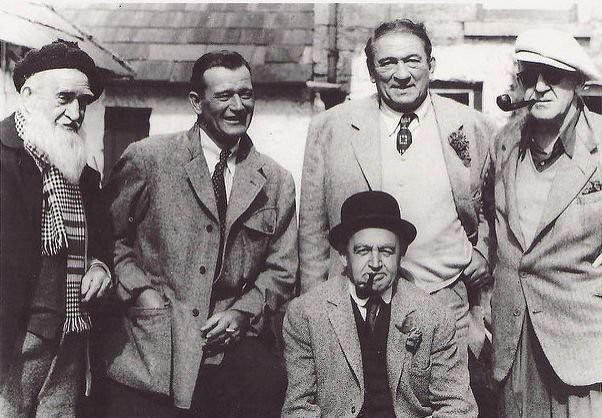
Rio Grande (1950) was the film that paved the way for The Quiet Man. It was the third of Ford’s cavalry films and it starred John Wayne, Maureen O’Hara, and Victor McLaglen– all three of whom would appear in The Quiet Man. It proved to be a good test-run for Wayne and O’Hara, whose on-screen chemistry was evident to all. The film was scored by Victor Young, who would go on to compose the memorable themes for The Quiet Man. Rio Grande was a box office success. As a result, Herbert Yates gave the go-ahead for Ford’s Irish movie. The film was budgeted for $1,750,000.
Richard Llewellyn, the author of How Green Was My Valley, expanded Maurice Walsh’s original short story, and then Ford’s regular screenwriter Frank Nugent wrote the finished script– in ten weeks. The Walsh story was very political and featured the protagonist, Shawn Kelvin, (Sean Thornton in the movie), joining an IRA flying column. There were overt references about the Irish rebellion and its war against the British. Undoubtedly, this political aspect would have scared studios who were only familiar with the content of the Walsh story. But John Ford dropped all that and instead emphasized the love story as well as the comedic aspects. The screen romance that developed in the script is atypical Ford since he was always known as a man’s director. By removing the “realistic” aspects of the original story, Ford helped shape it into a dream idyll of Ireland.
Sean Thornton (John Wayne), a boxer from America, returns to his birthplace in the Irish countryside and falls in love with a fiery local girl, Mary Kate Danaher (Maureen O’Hara). Trouble arises with her cantankerous brother (Victor McLaglen) over the payment of her dowry. To Sean, it’s just money, but to Mary Kate, it represents her property and identity– and it serves as a symbol of independence and equality. Without it, a woman just isn’t married. Squire Danaher refuses to turn it over to the newlyweds. Sean is hesitant to fight over it, but will he fight for her?
Ford wanted to shoot the film where it took place– in Ireland. In those days in Hollywood, it was rare to shoot a movie on location. In fact, when Ford made How Green Was My Valley, he created an entire Welsh village in California. He also wanted to shoot The Quiet Man in Technicolor– not in “Trucolor” (which was a cheaper process Yates used at Republic). For this production, Ford would have to get the huge Technicolor cameras from London where they’d be borrowed from the British studios. He ultimately got his way in both location and color photography. His cameraman on the film was Winton C. Hoch, who had shot She Wore a Yellow Ribbon (and would later shoot The Searchers).
The Quiet Man was photographed in Ireland in the summer of 1951. The location that was selected for the fictional “Innisfree” was the village of Cong in County Mayo, which is on the west coast of Ireland. (Ford originally considered County Galway where his parents were from.) It would be a six-week shoot with the cast staying at the Ashford Castle hotel in County Mayo. During their stay, Cong became wired for electricity; the town’s quaint quality had been part of its appeal as a location. In preparation for the daily shooting schedule, Ford and his team made extensive notes on the average temperatures and the average hours of bright sunshine during the course of a summer day. Some interiors were later shot at Republic as well as some obvious “exteriors.”
Around John Wayne and Maureen O’Hara, Ford assembled a stellar cast of professionals. Victor McLaglen, who was 65 years old when he played Squire Danaher, was one of the great character actors in Hollywood. He was a Scotsman who usually played Irish parts and in fact won an Oscar for The Informer, which some critics consider to be Ford’s true Irish masterpiece. McLaglen had been a former boxing champion for the British Empire; his proudest boast was surviving three rounds with Jack Johnson, the African-American heavyweight champion. Barry Fitzgerald, the prototypical Irishman who had starred in films like Going My Way, was cast as Michaeleen, the town matchmaker/bookmaker– and the overseer of propriety. Ford also cast his older brother Francis in the role of Dan Tobin. The supporting characters were recruited from Dublin’s Abbey Theatre. Maureen O’Hara was herself a Dubliner in real-life but here had to play a country lass. A family atmosphere abounded on the set: John Wayne’s four kids made an appearance in the movie; John Ford had his older brother, and Maureen O’Hara had her brothers in the cast as well. (Her brother Charles Fitzsimons helped scout locations for Ford.)
The Quiet Man showcases beautiful scenery and locations featuring the lush countryside. The vibrant greens create a picturesque landscape that suggests an imagined dream of Ireland. Against this romanticized image of the land, John Ford fashioned a beautiful romance. He was never mistaken for a director of great love stories, yet The Quiet Man features his most romantic imagery–from Sean and Mary Kate’s first kiss in the cottage to their rain-drenched embrace in the cemetery. The latter, in which the two escape from custom and restraint, is a particularly sensual scene famous for showing the water soaking through John Wayne’s silk shirt. For the men, there’s the famous donnybrook Wayne has with McLaglen. Though it’s built up as the climax of the film, the emphasis is more on comedy rather than action with the combatants occasionally interrupting the brawl for courtesies. Here, Ford is more concerned with showing everyone’s reaction to the fight. A much more somber sequence is shown earlier when we see a brief glimpse of Sean Thornton’s backstory in the boxing ring. It’s a very stylized, expressionistic sequence, and although it’s not very long and no punches are thrown, it inspired director Martin Scorsese in how he shot scenes in Raging Bull (1980).
A film about cultural conflicts, The Quiet Man shows the rituals of Irish courting which John Wayne’s character doesn’t fully understand. He represents us, the viewer, as we, too, try and understand the native customs. One criticism that has been levelled by those less-informed involves a scene in which John Wayne’s character drags Maureen O’Hara across the countryside. Obviously, violence is not to be celebrated, and in this age of #MeToo and the hyper-sensitivity towards anything that suggests gender roles, scenes that depict the physical nature of the characters’ relationship may be upsetting to modern sensibilities.
However, Maureen O’Hara’s character, a red-haired tempest, is every bit the match for John Wayne. She can dish out what she can take. But in the context of this scene, she wants Sean Thornton to come after her and do what he must to redeem himself in society’s eyes. She is playacting in order to help preserve the social order of rural Ireland. It’s not a scene about gratuitous violence for the sake of violence. Sean is literally acting out the “dragging home the bride” custom that went back centuries; in medieval times, families fought mock battles during the marriage ceremony. It was a staged event for the benefit of the community– a way to settle kinship relations and earn respect. Sean finally understands that marriage is very much a communal celebration in Ireland and he must act out his part. If an audience doesn’t understand the context and the roots of this tradition, they won’t understand why he deliberately drags her through a pasture and throws her at the feet of her brother.
The Quiet Man received seven nominations and won two Academy Awards for Best Director (John Ford) and Best Cinematography (Winton C. Hoch and second unit cinematographer Archie Stout). The film proved to be one of the biggest hits for Ford and Wayne. It was a film people embraced regardless of their nationality. It may not have been a true Irish film in that it was basically a Hollywood movie made in Ireland, but it is an Irish film in spirit and told with the Irish-American point-of-view. As stated, it was a personal film for its director– a wish-fulfillment from a man who in some way wanted to go back home to the land of his parents. John Ford wasn’t born in Ireland, but he fashioned a modern myth, a dream Ireland he could inhabit. It’s been noted that what he created with this film was a poem to Ireland.
Die-hard enthusiasts of the film are known as “Quiet Maniacs,” and with their help, the tourism trade in Cong, Ireland, has boomed over the years. This fascination and embrace of the film is captured in the wonderful documentary John Ford: Dreaming the Quiet Man. Those who were born decades after the film premiered still visit the site of the “Quiet Man cottage” and the “Quiet Man bridge”– and the famous Pat Cohan Bar where Irish hospitality and exuberance was fully on display. (Ironically, the building wasn’t a real bar at the time of shooting but is one now for the tourists.)
What survives today beyond the physical locations are the film’s values: home, community, family, and tradition. They are John Ford’s values– and they are the values of the Irish people– preserved on celluloid. In its wake, in the turbulent 1960s and beyond, the film would evoke an even greater nostalgia both for Ford and his audience. The modern world would always be encroaching, but through The Quiet Man, there was a place everyone could return to– like Sean Thornton seeking his ancestral home and wanting to escape the past and find peace. The desire to start anew somewhere else or to find rebirth and redemption– or to simply return home–are part of the storyline that resonate with viewers.
Raise a pint of Guinness (over at The Harp & Fiddle, of course) and then come on over to the old movie house on Prospect Ave. We look forward to sharing the joy of this wonderful film with all our patrons as well as with our honorary guest, Maggie McEldowney. Maggie is our ambassador to Ireland, and as we celebrate all things Irish, we’ll be rolling out the green carpet for our 2016 Rose of Tralee. We are honored to have her in our lobby before the show.
~MCH
